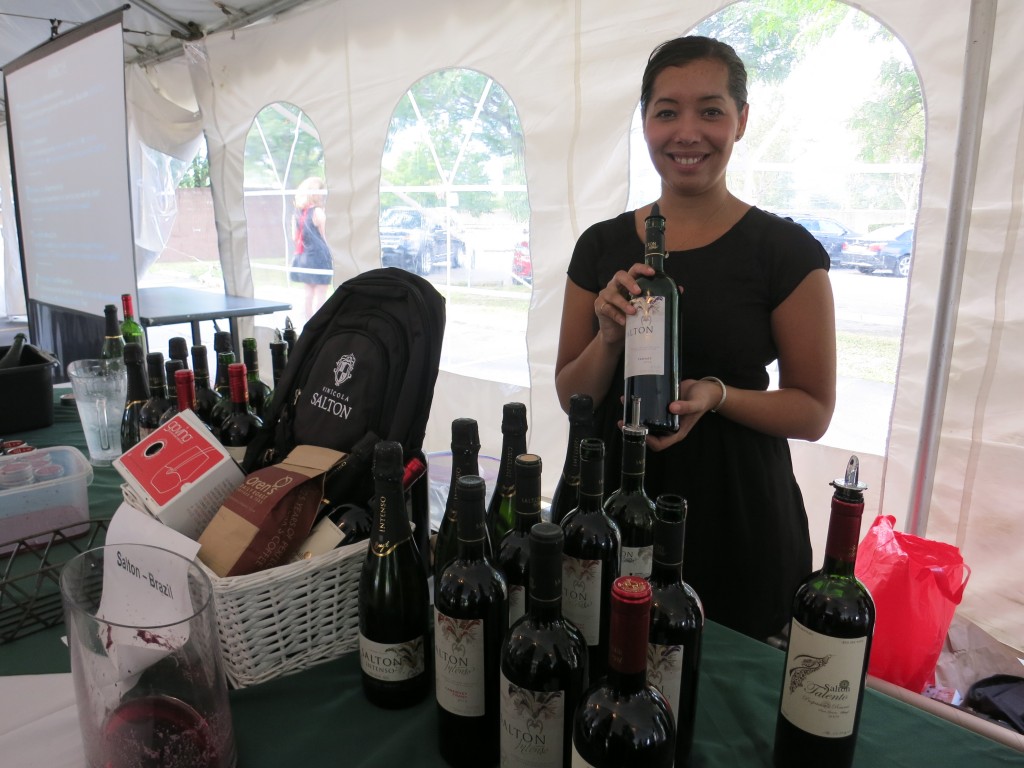Overdue For A Brazilian
Until recently, I’d never had a Brazilian — wax or wine. I found the idea of either one more than a little scary, and frankly unnecessary. But when I spied a table of Brazilian wines by Vinícola Salton at the recent Wine Bloggers Conference, I decided it was time to face my fears.
Founded in 1910, Salton is one of Brazil’s oldest wineries, but that’s not necessarily an advantage. According to The World Atlas of Wine, Brazil has long made uninteresting wine “because of where it was made: near centers of population, in areas of high humidity with fertile soils, by small farmers with rudimentary skills.” And indeed, Salton’s beautiful winery is located in the old Serra Gaúcha region, where, as The Oxford Companion to Wine explains, where “Average rainfall… is very high for a wine region,” and soils “have a high proportion of water-retaining clay.” As a result, “fungal diseases are a constant threat,” and wines from here tend to be of “basic quality.”
Fortunately, tradition has not stopped Salton from investing in new vineyards in the drier and less fertile region of Campanha along the northern border of Uruguay. In 2010, Salton purchased 1,100-some acres of vineyards in Campanha, which the World Atlas calls “the focus of fine wine development in Brazil, with particular attention now being paid to matching vine variety and soil type.”
It all sounds promising, but really, Brazilian wine? Even this odd wine drinker felt a little skeptical as I held out my glass for a sample.
—NV Salton Intenso Brut: Vanessa (pictured above) told me I was drinking a blend of Chardonnay and Riesling (!) from Campanha, but Salton’s website describes this wine as a blend of Chardonnay, Prosecco and Trebbiano from Serra Gaúcha. In any case, it has a subtle aroma of dried herbs, a fruity attack on the palate and a rather savory finish. I liked the flavor journey, and for $17, you can take it too. Other sparklers might be better values, but this is the obvious choice with which to celebrate Brazilian Independence Day (September 7).
—2012 Salton Intenso Cabernet Franc: This restrained but still-powerful wine had a dusky dark-fruit aroma, taut dark-fruit flavors, a perk of white-pepper spice and some balanced tannins on the finish. I liked it, and I wasn’t surprised to find out that it came from Campanha. The next wine, however, was a complete and total astonishment.
—2012 Salton Intenso Tannat: “This is a 100% Tannat? That’s brave,” I remarked, trying to sound as positive as possible. I enjoy Tannat in blends, but many of the varietal Tannats I’ve tried tend to be mouthfuls of tannins (see my controversial Tannat post here).
“It’s actually really light and elegant,” Vanessa replied, smiling despite my look of utter disbelief. A light and elegant Tannat seems about as likely as a light and elegant Arnold Schwarzenegger.
I tasted it and nearly spit it out in shock before I managed to spit it out with composure into the spit bucket. Where were the overpowering tannins? This Campanha Tannat tasted fruity and well-balanced, with some restrained spice and supple — supple! — tannins. Uruguay has got some Tannat competition.
—2009 Salton Talento: The Cabernet Sauvignon, Merlot and Tannat grapes in this Bordeaux-style blend are hand-harvested, and the quality control shows in the wine. It had a clean red-fruit aroma and it tasted beautifully balanced, with ripe fruit, ample spice, classy tannins on the finish and something earthy and funky underneath it all. The grapes come from both Campanha and Serra Gaúcha, which leads me to wonder if coaxing high-quality fruit from Serra Gaúcha might be possible after all. I wouldn’t hesitate to serve this to guests at a dinner party, ideally with some steak.
Brazil opened its markets to imported wine only in the 1990s, which means local wineries have had only about 20 years of competition. These wines are evidence that they haven’t wasted those two decades. There are some interesting things trickling out of Brazil these days, and should you encounter a Brazilian bottle on a wine list or in a shop, I recommend asking about it. Its quality might surprise you.
Brazil, Cabernet Franc, Cabernet Sauvginon, Sparkling, Tannat






